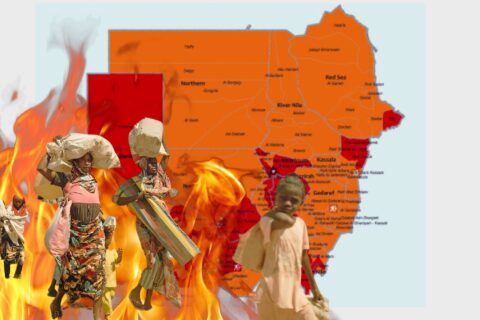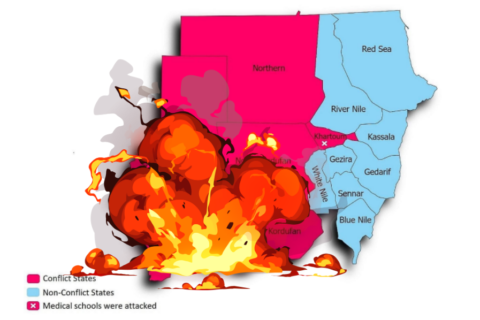
By Professor Abdul Azim Mirghani
On July 21/20, 1969, Earth time, humans had the opportunity for the first time to see the Earth as a small sphere enveloped by a delicate layer of clouds and the blue colors of the oceans and the dusty color of the land, through the images transmitted by the Apollo 11 spacecraft during its journey to the moon, in which there was no trace whatsoever of human presence, activities, or the structures they built. It became clear to humans that their failure to align their activities with the delicate pattern that enveloped the planet could lead to dangerous changes threatening their existence.
The impact of this view of our Earth from space had a profound effect on human thought, equivalent to the impact of Copernicus’ discoveries in the sixteenth century that the Earth is not stationary and not at the center of the universe. This view alerted people that their fate is tied to the fate of a fragile little sphere, and that their destiny is inseparable from its destiny. Failure to adapt their activities to the delicate pattern they observed surrounding it could lead to changes threatening their existence.
This was the beginning of a new era in the history of humanity marked by an increasing awareness of the environmental dangers facing it. Interest in environmental and forest issues grew consequently. This was embodied in a series of international environmental conferences aimed at protecting and improving the environment of our Earth, starting with the first environmental conference held in June 1972 in Stockholm, Sweden, which resulted in the “Our Common Future” declaration. The second International Environmental Conference was held in June 1992 in Rio de Janeiro, Brazil, known as the Earth Summit, followed by the Rio+20 Conference in June 2012, which resulted in the “Future We Want” declaration.
Meanwhile, international environmental conferences continued to be held annually, reaching about sixty conferences on climate change, biodiversity conservation, and combating desertification alone. However, despite these efforts, the situation remained the same, merely festivals of words without actions. As the saying goes, “More talk without action, content with criticism, and do not be surprised if the result is zero, as words do not grow trees.”
The United Nations, in its celebration of Earth Day this year, stated that environmental deterioration is still escalating, with rates of ocean pollution (plastic) and acidity increasing, extreme temperature rates rising, and floods and hurricanes unprecedented in size, intensity, force, and frequency reaching their peak. The number of animal and plant species threatened with extinction has reached one million. The annual deforestation rate has reached 4.7 million hectares, an area exceeding that of Denmark and 260 times the size of Kuwait.
Despite the importance of forests in achieving the goals of the Paris Agreement, and despite their prominent role in mitigating its effects, forests were not given direct attention in this agreement until 2015, more than two decades after the agreement was born. This was through Articles 4 and 5 of the Paris Agreement, with Article 4 stating that each party to the agreement should prepare nationally determined contributions (NDCs) detailing the actions it intends to take to address climate change effects, including significant contributions from forests from almost all countries. Article 5 called for encouraging parties to preserve and enhance carbon sinks, including forests.
Studies indicate that activities related to agriculture, forests, and other land uses contribute 23% of the total net human-generated greenhouse gas emissions causing global warming. Forests contribute by absorbing greenhouse gases and serving as carbon sinks, storing about 289 gigatons of carbon in their living tree mass, deadwood, and soil.
Estimates also indicate that if deforestation is stopped and reforestation is carried out simultaneously, carbon absorption processes could offset between 12-15% of the carbon emissions resulting from fossil fuel combustion. However, if deforestation continues, its contribution to total greenhouse gas emissions is estimated to be about 12-20%. Therefore, efforts to reduce deforestation rates and establish new forests help reduce carbon emissions and absorb them as well.
Until recently, people only associated the primary functions of forests and trees with timber production. They used to boast, saying, “Forest and people are lumberjacks.” However, there have been significant shifts in people’s perceptions of forests and trees recently. They now recognize their new roles in preserving biodiversity, protection, and prevention of global warming phenomena and climate change, without negating their traditional roles recognized previously, such as those related to livelihoods, prosperity, recreation, and even saving them from disasters.
The story of “Niyi Lei,” a six-year-old child, recounted during the opening session of the Climate Change Conference held in Copenhagen, Denmark, in 2009, illustrates this. He spoke of his and his family’s experience with a devastating hurricane, similar to those hurricanes that are manifestations of the climate change the world is currently experiencing. He said: “My mother held my younger brother, and my elder sister held my younger sister. The winds and rains intensified, and the waters flooded the banks. We planted our feet in the mud so that the currents wouldn’t sweep us away. When the water rose to my father’s chest level, we had to climb the trees. Suddenly, the tree I was clinging to fell due to the force of the wind. I got separated from my parents, so I clung to the tree trunk and floated with it, being swept away by the current. The rain was pouring violently at that moment, and its impact on my back was extremely painful. I remained in that state all night, in a state of intense fear and terror.”
Thus, the child “Niyi Lei” survived imminent death by clinging to a tree, just as our ancient ancestors did by seeking refuge in trees for protection from predatory animals that pursued them, and just as the second father of humanity, Noah, sought refuge in trees to build the ark of planks and ribs that carried him and those with him, by the permission of their Lord, to safety. There is nothing new under the sun, and everything new is nothing but old rearranged in a different form and a new pattern. This was my contribution to the third annual celebration of our Earth.
My prayers for salvation, and my regards.
Abdul Azim Mirghani



